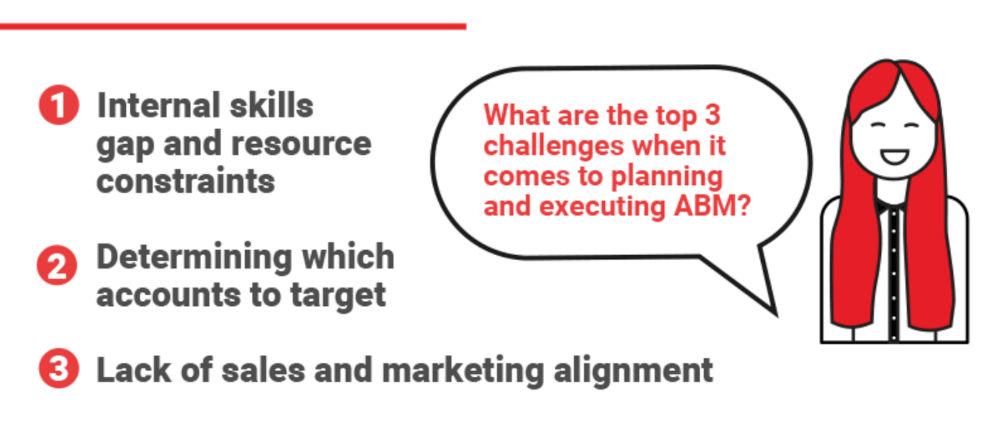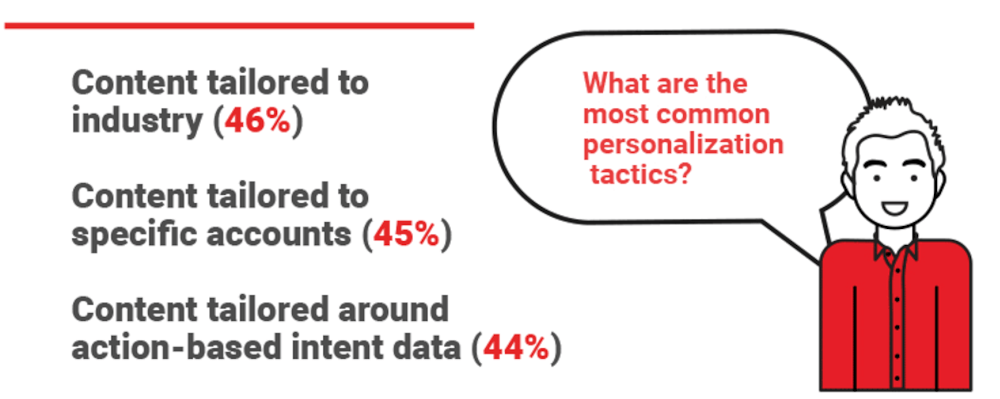Account-based marketing (ABM) is a strategic approach that focuses marketing resources on engaging specific, targeted accounts rather than a broad market. By treating each prospective account as a distinct market, ABM allows businesses to personalize their marketing efforts and deliver more relevant and valuable experiences to decision-makers within those accounts. For businesses looking to maximize their efforts, integrating ABM and inbound strategies can further enhance engagement and results.
The importance of ABM lies in its ability to drive better ROI, increase deal sizes, and shorten sales cycles by aligning sales and marketing efforts around the accounts with the highest potential value. However, implementing an effective ABM strategy comes with its own set of challenges that businesses must navigate.
Big ABM challenges and how to overcome them
From identifying the right accounts to target and building solid account lists, to addressing misalignment between sales and marketing teams, and measuring the performance of ABM campaigns, there are numerous obstacles that can hinder success.
1. Building and determining account lists
Creating a strong account list challenges businesses with the need for accurate data collection and the identification of key decision-makers. To achieve the personalization that ABM requires, understanding the unique attributes and pain points within each prospective account is crucial. Additionally, strategically prioritizing accounts is a delicate balance of assessing their potential value against the business’s capacity to engage.
Solution: Streamlining account selection
Refining the process of building an account list involves leveraging reliable data sources, employing data analysis tools, and conducting thorough research to verify information. Establishing clear criteria for account selection and investing in account intelligence platforms can aid in identifying decision-makers. Prioritization should be a systematic process, based on data-driven insights and alignment with company capabilities and targets.
Unsure how to pick target accounts for ABM? Partner with Inbox Insight that can leverage expert insights and data to craft your list. Create an ICP based on your most successful customers by revenue, profit, win rate, or retention. Identify similar companies using intent data tools, pinpointing those actively seeking your services.
2. Prioritizing which accounts to target
Selecting the right accounts is important in ABM. Prioritization should focus on accounts that align with business goals and promise high revenue potential. Segmenting target accounts based on criteria such as industry, size, and revenue enhances the ability to customize outreach to meet specific needs.
Using intent data and behavioral insights can pinpoint accounts actively seeking similar solutions, enabling prioritization of those more advanced in the buying process. Additionally, evaluating the strategic value of accounts, considering factors like long-term growth potential and cross-selling opportunities, can guide focus towards more lucrative and strategically significant engagements.
Solution: Enhancing target account selection
To improve account targeting accuracy, companies should integrate comprehensive data analyses and harness advanced analytics to profile and predict potential high-value accounts with greater precision. Employing predictive analytics and machine learning can further refine these efforts, ensuring a focus on the most promising prospects.
3. Determining resources and entitlements
Success in ABM heavily depends on appropriate resource allocation, including budget, personnel, and technology. Balancing between investing in expensive high-value account campaigns and general marketing and sales activities is critical. Establishing a dedicated team and acquiring the right ABM tools are both costly yet essential steps that require strategic budgeting and wise recruitment choices.
Technological investments should focus on tools that facilitate effective account selection and campaign management, though integrating these into existing systems presents its own set of challenges.
Solution: Strategic resource management
Organizations need to engage in thorough planning and adopt a strategic stance on resource allocation. By defining clear roles within the ABM team, tying expenditures to predicted ROI, and adopting scalable technologies, companies can more effectively manage their resources. Training and continuous skill development for ABM teams can further maximize efficiency and impact, ensuring the business is positioned to capitalize on ABM-driven opportunities efficiently.
4. Addressing sales and marketing misalignment in ABM
According to our ABM infographic, the lack of alignment between sales and marketing teams ranks as one of the top three challenges facing companies. ABM requires tight collaboration and coordination between these two critical functions as they work towards the common goal of engaging and converting high-value accounts.

When sales and marketing operate in silos, it can lead to a disconnect in messaging, targeting, and overall strategy. Marketing may be pursuing accounts that are not a priority for sales, or sales may be unaware of the marketing efforts and content aimed at their key accounts. This misalignment can result in wasted resources, missed opportunities, and a disjointed buyer experience.
Solution: Enhancing alignment between sales and marketing
To tackle the challenge of sales and marketing misalignment, several strategies can be adopted:
- Establishing shared goals: Foster consistent communication to ensure both teams are aligned with the organization’s objectives
- Aligning metrics: Integrate technology platforms to create a unified view of targets and strategies, ensuring both teams work towards the same indicators of success
- Regular strategy meetings and joint training: Facilitate meetings and training initiatives on a regular basis to improve understanding and cooperation between sales and marketing
- Implementing a shared platform: Utilize a shared platform for real-time access and updates on account information by both teams. Employ collaboration tools that enhance communication and joint oversight of campaigns
By focusing on these areas, organizations can bridge gaps between sales and marketing, streamlining efforts, and enhancing the coherence and effectiveness of campaigns. Interestingly, as companies progress in their ABM maturity, we see a decline in meeting frequency. In fact, the majority (41%) of fully synchronized ABM programs only meet quarterly. This suggests that as companies become more mature in their ABM programs, they require less frequent meetings as they have established more efficient and effective processes.
5. Decision-makers can be hard to reach
Reaching the right decision-makers is a common obstacle in B2B. Even with a precisely crafted ICP and account lists, it’s still a challenge to connect with those who have the authority to make purchasing decisions. Decision-makers can be scattered throughout different levels and departments, making it unclear where the real power lies.
Connecting with high-level executives is especially tough as they are often insulated by layers of gatekeeping.
Solution: Personalized outreach

The key is to develop messages that directly address the specific concerns, goals, and needs of each decision-maker. A good approach grabs their attention, proves your expertise in their industry, and distinguishes you from competitors.
To be more effective and persuasive, use your knowledge of industry challenges, capitalize on shared connections, and apply insights that resonate with those in command. Successfully doing this not only gets you noticed but also lays the groundwork for trust and ongoing business relationships.
Once you have crafted an audience focused message, you can deploy targeted demand generation tactics. These will reach the accounts from your list with your content and engage key decision makers. Combining content syndication, paid media, and SDR outreach against your target account list with customized content increases account penetration and brand awareness faster than disparate channels working in silos.
6. Addressing excess and vanity data
In ABM, the challenge isn’t just managing the sheer volume of data but differentiating valuable insights from “vanity data.” Metrics such as website visitors or social media followers may seem impressive at first glance, but lack a direct impact on business outcomes and strategy, potentially diverting attention from more meaningful analytics.
Instead, successful ABM strategies should focus on metrics that directly correlate with revenue generation and account engagement.
Solution: Prioritizing relevant data
The key to effective data management in ABM is to filter through the noise by prioritizing data aligned with specific business objectives and the nuances of target accounts. Employing tools and analytical models that sift through and emphasize pertinent data can help businesses avoid data overload. This strategic focus ensures that marketing efforts are guided by actionable insights, enhancing engagement and driving profitability.
7. Technology limitations and integration challenges
Technology is integral to ABM, but integrating varied tools—like CRM, marketing automation, data enrichment services, and content management systems—poses significant challenges. Difficulty integrating these disparate systems often stems from complex and costly processes, particularly when involving legacy systems or isolated datasets.
Further compounding the challenge are issues like lack of interoperability and standardization between different technologies, leading to inconsistent data, duplications, and efficiency barriers that can weaken ABM campaigns. Additionally, the constant evolution of technology demands frequent updates, causing potential disruptions and requiring additional resources for implementation and training.
Solution: Mapping ABM technology integration
To solve these issues, companies should conduct audits to pinpoint integration weaknesses and overlaps. Investment in technologies with strong integration features and adaptable architectures is essential. Similarly, encouraging interdepartmental cooperation among marketing, sales, and IT can help unify integration efforts, ensuring technology effectively supports ABM strategies.
8. Too many tech tools
The accumulation of specialized tools often complicates technology stacks, leading to inefficiencies, data fragmentation, and a disjointed ABM strategy. An overload of such tools may obscure a unified account view, undermine consistent engagement tracking, and cause resource drain due to the need for extensive management, training, and maintenance.
Solution: Streamlining the ABM tech stack
To counteract these issues, organizations should periodically audit their tech suite to identify opportunities for consolidation. Prioritizing integrated platforms capable of multi-functional support promotes efficiency and data cohesion. Key to this approach is fostering alignment and collaboration between marketing and sales, alongside setting structured guidelines for technology use and coordination. Optimizing technology use in this way can significantly bolster the effectiveness of ABM initiatives.
Sometimes onboarding new tech is not the solution because of lack of manpower to actually use it consistently…
9. Internal skills gap and resource constraints
Businesses often face challenges implementing account-based marketing due to internal expertise and resource limitations. In fact, according to our ABM research report, the most significant challenge for UK-based marketers in planning and executing an ABM strategy was the internal skills gap and resource constraints at 34%.
Uncover the key regional differences in the current state of ABM across the US and UK here.
ABM necessitates a unique set of skills that may be lacking within existing marketing and sales teams, and it requires dedicated personnel and budget.
Key skills required for ABM:
- Data analysis and management: Successful ABM depends on high-quality data to identify the right accounts, personalize messages, and gauge campaign performance
- Content creation and personalization: ABM campaigns need highly personalized content, demanding specialized creators and knowledge of the target’s needs and decision-making processes
- Campaign orchestration and multichannel marketing: Handling various channels and touchpoints across teams requires skills in campaign planning and lead nurturing, ensuring a cohesive experience for the targeted accounts
- Measurement and analytics: Accurate measurement and analytics are critical, yet tracking the ROI and effectiveness of ABM strategies is complex
Solution: Overcoming ABM skills gap and resource limitations
To overcome skill gaps and resource issues, organizations should consider:
- Providing training and development for current employees
- Hiring specialists or contracting with external consultants or account based marketing agencies
- Allocating targeted budgets and resources to support ABM efforts
By addressing these elements, businesses can better set up their ABM strategies and ensure that they’re equipped to tackle the inherent complexities of targeted marketing initiatives.
10. Measuring ABM performance
Measuring the success of ABM is essential but complex due to multiple touchpoints and varied channels, complicating clear revenue attribution. It’s crucial to establish relevant metrics tailored to business goals to fully grasp ABM’s impact.
Instead of traditional lead-centric metrics, ABM focuses on account-level engagement, including metrics like engagement scores, sales pipeline velocity, and revenue per account. These metrics provide a more comprehensive view of ABM effectiveness.
- Challenges with data integration: Consistent and integrated data from marketing automation, CRM, and web analytics platforms are vital yet challenging, impacting the reliability of analysis and reporting
- Prolonged sales cycles: ABM’s longer sales cycles further challenge the clear attribution of marketing efforts to revenue. Adopting multi-touch attribution models can offer deeper insights into how each interaction influences the buyer’s journey
- Track sales activity against marketing qualified accounts: You should develop a reporting framework that looks at engagement by your accounts in terms of account penetration and intent. This should show you accounts engaging with content, and where there are multiple recent leads generated. Then you can prioritize engaging these accounts with sales and flag low activity that might damage conversion opportunities to managers.
Solution: Implementing a holistic measurement strategy
To optimize ABM performance, adopt a holistic measurement approach that encompasses the entire customer lifecycle, from initial awareness through final deal closure and beyond to post-sale activities. Aligning these metrics with broad business objectives enables the extraction of actionable insights, facilitating informed strategic decisions and continuous enhancement of ABM initiatives.
Get started with a complimentary ABM lookalike list






